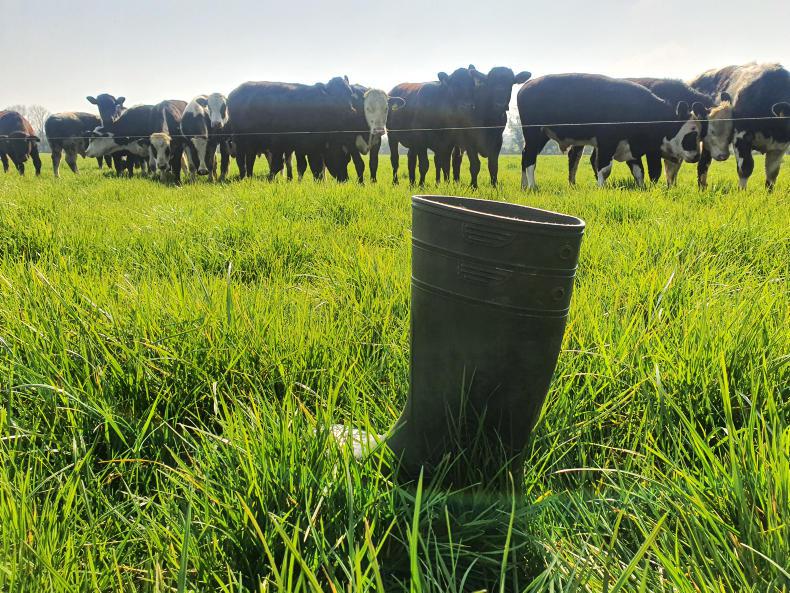Ground conditions are very good in the east and southeast, while those in the west and northwest will still need to pick and choose the driest fields for stock to turned out to. It is amazing what a few dry days can do for ground at this time of year so it is important to walk fields regularly as the picture changes quite quickly.

Grazing off silage ground prior to closing up can increase the silage Dry Matter Digestibility (DMD) figure by up to 5 percentage points.
The forecast for the coming week looks promising, with only light showers forecast for some areas. Therefore, where possible, at least some stock should be turned out to grass.
Thrive demo farm
On the Irish Farmers Journal dairy-calf-to-beef demonstration farm outside Cashel, Co Tipperary, 140 yearlings have been let out to grass over the last week. Initially they were let out in smaller groups of 12 to 15 while ground conditions were still quite delicate. On Friday, farmer John Hally began increasing group numbers as we need to increase the grazing pressure – especially on silage ground that needs to be grazed in the next week to 10 days.

The average sward height of this paddock was 10.5cm.
It is a good idea to graze off silage ground prior to closing as it can increase the silage dry matter digestibility (DMD) figure by up to 5 percentage points. Grazing helps remove any older dead material that will have built up over the winter months. While this grass may not seem to be old or rank just now, if it is allowed to grow for another eight to 10 weeks it will be of much lower feed quality at that stage.

The aim is to have all silage ground grazed by 5 April.
Turnout checks
Prior to turnout it is worth taking a walk around the perimeter fence to check for any breaks or earthing issues with electric fencing. Having good power in the fence at turnout is essential so that stock have a healthy respect for it from day one.
Where the plan is to sub-divide fields or paddocks with temporary wire, wait until cattle are out, have had their run-around, and are settled before putting it up.

Temporary wire being used to split paddocks in two to help increase grass utilisation.
All water troughs should be cleaned out and make sure they are filling correctly also.
Clostridial diseases
Early spring can be a high-risk period for clostridial diseases such as blackleg. Ensure all cattle have received their annual booster prior to turnout. Where cattle are being vaccinated for the first time, they will need a booster shot four weeks after the initial vaccine to give them greater immunity. Where calves are being treated they should be at least one month old before getting their first shot.

Temporary wire being used to split paddocks in two to help increase grass utilisation.
Ground conditions are very good in the east and southeast, while those in the west and northwest will still need to pick and choose the driest fields for stock to turned out to. It is amazing what a few dry days can do for ground at this time of year so it is important to walk fields regularly as the picture changes quite quickly.

Grazing off silage ground prior to closing up can increase the silage Dry Matter Digestibility (DMD) figure by up to 5 percentage points.
The forecast for the coming week looks promising, with only light showers forecast for some areas. Therefore, where possible, at least some stock should be turned out to grass.
Thrive demo farm
On the Irish Farmers Journal dairy-calf-to-beef demonstration farm outside Cashel, Co Tipperary, 140 yearlings have been let out to grass over the last week. Initially they were let out in smaller groups of 12 to 15 while ground conditions were still quite delicate. On Friday, farmer John Hally began increasing group numbers as we need to increase the grazing pressure – especially on silage ground that needs to be grazed in the next week to 10 days.

The average sward height of this paddock was 10.5cm.
It is a good idea to graze off silage ground prior to closing as it can increase the silage dry matter digestibility (DMD) figure by up to 5 percentage points. Grazing helps remove any older dead material that will have built up over the winter months. While this grass may not seem to be old or rank just now, if it is allowed to grow for another eight to 10 weeks it will be of much lower feed quality at that stage.

The aim is to have all silage ground grazed by 5 April.
Turnout checks
Prior to turnout it is worth taking a walk around the perimeter fence to check for any breaks or earthing issues with electric fencing. Having good power in the fence at turnout is essential so that stock have a healthy respect for it from day one.
Where the plan is to sub-divide fields or paddocks with temporary wire, wait until cattle are out, have had their run-around, and are settled before putting it up.

Temporary wire being used to split paddocks in two to help increase grass utilisation.
All water troughs should be cleaned out and make sure they are filling correctly also.
Clostridial diseases
Early spring can be a high-risk period for clostridial diseases such as blackleg. Ensure all cattle have received their annual booster prior to turnout. Where cattle are being vaccinated for the first time, they will need a booster shot four weeks after the initial vaccine to give them greater immunity. Where calves are being treated they should be at least one month old before getting their first shot.

Temporary wire being used to split paddocks in two to help increase grass utilisation.











 This is a subscriber-only article
This is a subscriber-only article










SHARING OPTIONS: